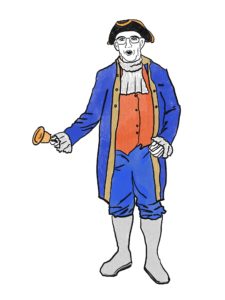On May 9, 2018, the Historical Society of Moorestown and the Moorestown Library co-hosted a presentation by Dr. Jonathan Mercantini, who chairs the History Department at Kean University. The subject was, “The Rise and Fall of the Negro Leagues.”
Dr. Mercantini discussed the sad truth of America’s Pastime during the Jim Crow Era, which was that African-American players were prohibited from taking the field with white players. But segregation wasn’t limited to the South; it was a national phenomenon.
Because black players couldn’t join teams or compete with white players, Negro Leagues were established. During the Leagues’ heyday, 1898-1946, some of the most remarkable players in history populated the Leagues. However, since the Negro Leagues tended to lack money and organization, and records were poorly kept, if at all, they would disband and re-establish themselves time and again. It didn’t help that stadiums and concessions were owned by whites, which meant that raising money for the Leagues became all the more difficult.
In northern cities, due to the Great Migration of African-Americans from South to North, eventually some African-Americans were well-off enough to patronize the Negro Leagues. As an example, Dr. Mercantini cited Effa Manley and her husband, Abe, who owned the Newark Eagles in the 1930s and 40s. Their team had its share of glory. In 1946, the Newark Eagles won the World Series against another Negro Leagues team, the Kansas City Monarchs, at Ruppert Stadium. Other Negro Leagues teams in New Jersey included the New York Black Yankees, who played at Hinchcliffe Stadium in Paterson.
Dr. Mercantini said that the Kansas City Monarchs was the first team in all of baseball, not just in the Negro Leagues, to play at night, under lights. This practice made games more accessible to African-American spectators, who often worked longer days than whites. He described some of the exciting traditions of Negro Leagues baseball, such as double-headers, which involved four separate teams playing in one day, rather than the same two teams playing twice in one day, which is the type of double-header that most people are familiar with today. Then there was “barnstorming,” or touring exhibition games, based on a circus model. Also, Negro Leagues teams tended to feature a “more improvisational” style of play. “Jackie Robinson,” said Dr. Mercantini, “epitomized that more improvisational, more aggressive, style of baseball,” which involved, among other things, stealing bases and turning doubles into triples.
When, in 1947, Robinson joined the Brooklyn Dodgers, a National League team, becoming the first African-American to play in Major League baseball, he was subjected to terrible heckling by Philadelphia fans. But he showed them. That year, he stole 29 bases; the second-highest number was 14!
Larry Doby, a player for the Newark Eagles, became the second black player to integrate the Major Leagues, shortly after Jackie Robinson went to the Dodgers, when Doby was recruited by the Cleveland Indians, an American League team.
It is not surprising that, as Dr. Mercantini remarked, the integration of the Major Leagues led to the demise of the Negro Leagues. But the distinctive lore of the Negro Leagues survives.
The Historical Society of Moorestown and the Moorestown Library would like to thank the professor for a very enlightening evening! This event was made possible in part by the Elizabeth Tuttle Foundation.
-Liz Rosenthal
The Rise and Fall of the Negro Leagues
Post a comment.




